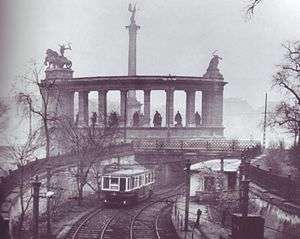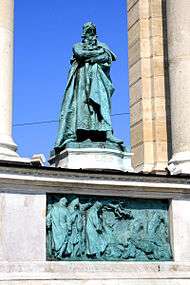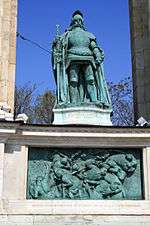Hősök tere
| Budapest, including the Banks of the Danube, the Buda Castle Quarter and Andrássy Avenue | |
|---|---|
| Name as inscribed on the World Heritage List | |
 | |
| Type | Cultural |
| Criteria | ii,iv |
| Reference | 400 |
| UNESCO region | Hungary |
| Coordinates | 47°30′54″N 19°4′40″E / 47.51500°N 19.07778°E |
| Inscription history | |
| Inscription | 2002 (26th Session) |
 Location of Hősök tere in Budapest. | |
Hősök tere (Hungarian pronunciation: [ˈhøːʃøk ˈtɛrɛ]; English: Heroes' Square) is one of the major squares in Budapest, Hungary, noted for its iconic statue complex featuring the Seven Chieftains of the Magyars and other important national leaders, as well as the Tomb of the Unknown Soldier. The square lies at the outbound end of Andrássy Avenue next to City Park (Városliget). It hosts the Museum of Fine Arts and the Műcsarnok. The square has played an important part in contemporary Hungarian history and has been a host to many political events, such as the reburial of Imre Nagy in 1989. The sculptures were made by sculptor Zala György from Lendava.
The site

Hősök tere is surrounded by two important buildings, Museum of Fine Arts on the left and Palace of Art (or more accurately Hall of Art) on the right. On the other side it faces Andrássy Avenue which has two buildings looking at the square — one is residential and the other one is the embassy of Serbia (former Yugoslavian embassy where Imre Nagy secured sanctuary in 1956).
The central feature of Heroes' Square, as well as a landmark of Budapest, is the Millennium Memorial (Hungarian: Millenáriumi Emlékmű, also translated Millennium Monument or Millennial Monument). Construction began in 1896 to commemorate the thousandth anniversary of the Hungarian conquest of the Carpathian Basin and the foundation of the Hungarian state in 1896, and was part of a much larger construction project which also included the expansion and refurbishing of Andrássy Avenue and the construction of the first metro line in Budapest (Hungarian: Földalatti). Construction was completed in 1900, which was when the square received its name.
When the monument was originally constructed, Hungary was a part of the Austro-Hungarian Empire and thus the last five spaces for statues on the left of the colonnade were reserved for members of the ruling Habsburg dynasty. From left to right these were Ferdinand I (relief: Defense of the Castle at Eger); Leopold I (relief: Eugene of Savoy defeats the Turks at Zenta), Charles III, Maria Theresa (relief: The Hungarian Diet votes support "vitam et sanguinem") and Franz Joseph (relief: Franz Joseph crowned by Gyula Andrássy). The monument was damaged in World War II and when it was rebuilt the Habsburgs were replaced by the current figures.
On 16 June 1989 a crowd of 250,000 gathered at the square for the historic reburial of Imre Nagy, who had been executed in June 1958.
There are also three other squares in Budapest entitled Hősök tere, in Soroksár, Békásmegyer and Rákosliget.
Behind the cenotaph but within the decorative chain is a flat bronze plate which marks the site of an artesian well whose drilling was completed in 1878 by Vilmos Zsigmondy. This well provides water for the Széchenyi Baths behind the monument and the Dagály Baths in the Népfürdő utca. The well reached a depth of 971 meters and produces 831 liters of hot water per minute at 74 degrees Celsius
The Heroes' Square monument has a 90% duplicate in Shanghai Global Paradise, Shanghai. Since its opening in 1996, it has been mostly degraded and most statues removed.
Millennium Monument
At the front of the monument is a large stone cenotaph surrounded by an ornamental iron chain. The cenotaph is dedicated "To the memory of the heroes who gave their lives for the freedom of our people and our national independence." While some guide books refer to this as a "tomb" it is not a burial place.
The back of the monument consists of two matched colonnades, each with seven statues representing great figures of Hungarian history.
This is a list of the statesmen who are portrayed by the sculptures in the semi-circular arcades of the monument. The topic of the relief below each figure is given below the name.
Statues of the Column
-

The column
-

The top of the column depicts Archangel Gabriel, who holds the Hungarian Holy Crown and the apostolic double cross in his hands
-

Left side view of some of the statues of the Seven chieftains of the Magyars
Directly behind the cenotaph is a column topped by a statue of the archangel Gabriel. In his right hand the angel holds the Holy Crown of St. Stephen (Istvan), the first king of Hungary. In his left hand the angel holds a two barred apostolic cross, a symbol awarded to St. Stephen by the Pope in recognition of his efforts to convert Hungary to Christianity. In Hungarian it is referred to as the double cross or the apostolic double cross.
At the base of the column is a group of seven mounted figures representing the Magyar chieftains who led the Hungarian people into the Carpathian basin. In the front is Árpád, considered the founder of the Hungarian nation. Behind him are the chieftains Előd, Ond, Kond, Tas, Huba, and Töhötöm (Tétény). Little survives in the historical record about these individuals and both their costumes and their horses are considered to be more fanciful than historically accurate.
Statues of the left colonnade
Topping the outer edge of the left colonnade is a statue of a man with a scythe and a woman sowing seed, representing Labor and Wealth. At the inner top edge of the left colonnade is a male figure driving a chariot using a snake as a whip representing War.
-

The couple of Labor and Wealth (on the left colonnade)
-

Man with a Snake the symbol of War
-

Stephen I of Hungary, King St. Stephen receives the crown from an emissary of the Pope
-

Ladislaus I of Hungary, King St. Ladislaus slays the Cumanian abductor
-

Coloman of Hungary, King Coloman prohibits the burning of witches
-

Andrew II of Hungary, King Andrew II leads a crusade to the Holy Land
-

Béla IV of Hungary, King Béla IV rebuilds the country after the Mongol invasion
-

Charles I of Hungary, King Ladislaus IV defeats Ottogar at the battle of Marchfeld
-

Louis I of Hungary, King Louis the Great occupies Naples
Statues of the right colonnade
On the facing end of the right colonnade is a female figure in a chariot holding a palm frond representing Peace. In the corresponding position on the top of right colonnade is a statue of a man holding a little golden statue and a woman with a palm frond representing Knowledge and Glory.
-

The female statue of Peace
-

The couple of Knowledge and Glory (on the right colonnade)
-

Matthias Corvinus, King Matthias with his scholars
-

István Bocskay, Hajdú soldiers defeat the Habsburg imperial forces
-

Gabriel Bethlen, Bethlen concludes a treaty with Bohemia
-

Francis II Rákóczi, Prince Rákóczi returns from Poland
-

Lajos Kossuth, Kossuth rallies the peasants of the Great Plain
Photo Gallery
The Millennium Monument
-

Heroes' Square – at night
-

Aerial
The buildings of the square
-

Kunsthalle Budapest at the right side of the Millennium Monument
-

Kunsthalle, The main Entrance
-

Museum of Fine Arts at the left side of the Millennium Monument
-

Museum of Fine arts: The main entrance
-

Behind the Millennium Monument: The Left side of gothic Vajdahunyad Castle
References
- Hajós, György, Heroes' Square, Municipality of Budapest (2001)
- Gerő, András, Heroes' Square Budapest, Corvina (1990)
External links
| Wikimedia Commons has media related to Heroes' Square (Budapest). |
Coordinates: 47°30′55″N 19°04′41″E / 47.51528°N 19.07806°E


